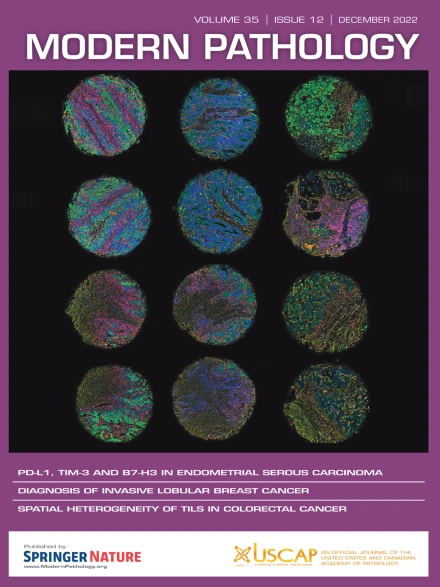NUTM1/NUTM2B-Rearranged Intra-abdominal Sarcomas: A Distinct Entity From Sarcomas With ESR1 Overexpression as a Therapeutic Target
IF 5.5
1区 医学
Q1 PATHOLOGY
引用次数: 0
Abstract
Emerging evidence reports that NUTM1 rearrangements also occur in noncarcinomas, including skin tumors, leukemias, and high-grade sarcomas. Recently, a distinct subset of NUTM1-rearranged sarcomas was identified intra-abdominally, mainly of colonic origin, differing molecularly, based on limited methylation analysis. This study aimed to further explore 5 patients with NUTM1/NUTM2-rearranged intra-abdominal sarcomas at clinical, histologic, immunohistochemical, and transcriptomic levels. The included patients were all females without a history of cancer; their mean age was 51.6 years (range: 29-73). Tumors were located intra-abdominally, including the sigmoid colon, the vesicouterine ligament, and the submucosa of the ascending colon. Three patients experienced disease progression despite chemotherapy, resulting in death within 1 to 8 months from diagnosis. Diverse histologic patterns were observed, including epithelioid proliferation, cohesive and dyscohesive areas, rhabdoid cells, and spindle cell fascicles. Immunohistochemically, most markers were negative; all cases were positive for estrogen receptors, whereas NUT was positive only in NUMT1-rearranged cases. MXD4::NUTM1 fusions were identified in 3 cases, and in the other cases, NUTM2B fusions were identified with either MXD4 or MXI1. Uniform manifold approximation and projection clustering analysis demonstrated that NUTM1/NUMT2B-rearranged intra-abdominal sarcomas clustered together, apart from other neoplasms. The hierarchical clustering dendrogram displayed a greater separation of NUTM1/NUMT2B intra-abdominal-rearranged sarcomas from NUTM1-rearranged carcinomas and NUTM1-rearranged porocarcinomas, from MGA::NUTM1 sarcomas and NUTM1-rearranged endometrial stromal sarcomas. ESR1 expression was significantly higher in NUTM1/NUMT2B-rearranged intra-abdominal sarcomas. NUTM1/2B-rearranged intra-abdominal sarcomas herein represent an emerging entity distinct from the sarcomatous lineage at the transcriptomic level and characterized by its overexpression of estrogen receptors, which could be an indication for another therapeutic option.
NUTM1/ nutm2b重排腹内肉瘤:与ESR1过表达的肉瘤不同的实体作为治疗靶点
新出现的证据表明,NUTM1重排也发生在非癌性肿瘤中,包括皮肤肿瘤、白血病和高级别肉瘤。最近,基于有限的甲基化分析,在腹腔内发现了一个独特的nutm1重排肉瘤亚群,主要是结肠起源,分子上不同。本研究旨在进一步从临床、组织学、免疫组织化学和转录组学水平探讨5例NUTM1/ nutm2重排腹内肉瘤。纳入的患者均为无癌症病史的女性;平均年龄51.6岁(29 ~ 73岁)。肿瘤位于腹腔内,包括乙状结肠、膀胱子宫韧带和升结肠粘膜下层。3例患者在化疗后仍出现疾病进展,在诊断后1至8个月内死亡。观察到不同的组织学模式,包括上皮样增生、内聚和非内聚区、横纹肌细胞和梭形细胞束。免疫组化,大多数标记物阴性;所有病例雌激素受体均呈阳性,而NUT仅在numt1重排病例中呈阳性。3例与MXD4::NUTM1融合,其余病例与MXD4或MXI1融合。UMAP聚类分析表明,除了其他肿瘤外,NUTM1/ numt2b重排的腹腔内肉瘤聚集在一起。分层聚类树状图显示,NUTM1/ numt2b腹腔内重排肉瘤与NUTM1重排癌和NUTM1重排的孔癌,与MGA::NUTM1肉瘤和NUTM1重排的子宫内膜间质肉瘤有较大的分离。在NUTM1/ numt2b重排的腹腔内肉瘤中,ESR1的表达明显升高。nutm1 / 2b重排腹内肉瘤在转录组水平上代表了一种与肉瘤谱系不同的新兴实体,其特征是雌激素受体的过表达,这可能是另一种治疗选择的指征。
本文章由计算机程序翻译,如有差异,请以英文原文为准。
求助全文
约1分钟内获得全文
求助全文
来源期刊

Modern Pathology
医学-病理学
CiteScore
14.30
自引率
2.70%
发文量
174
审稿时长
18 days
期刊介绍:
Modern Pathology, an international journal under the ownership of The United States & Canadian Academy of Pathology (USCAP), serves as an authoritative platform for publishing top-tier clinical and translational research studies in pathology.
Original manuscripts are the primary focus of Modern Pathology, complemented by impactful editorials, reviews, and practice guidelines covering all facets of precision diagnostics in human pathology. The journal's scope includes advancements in molecular diagnostics and genomic classifications of diseases, breakthroughs in immune-oncology, computational science, applied bioinformatics, and digital pathology.
 求助内容:
求助内容: 应助结果提醒方式:
应助结果提醒方式:


